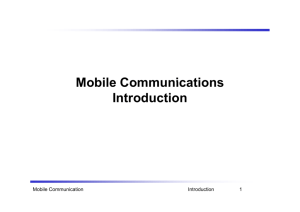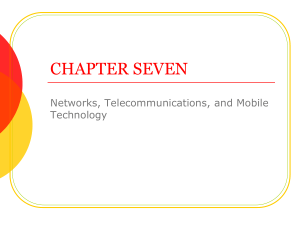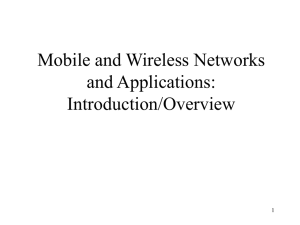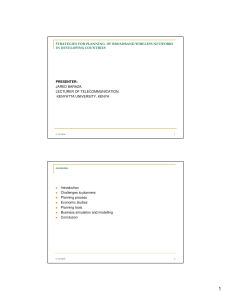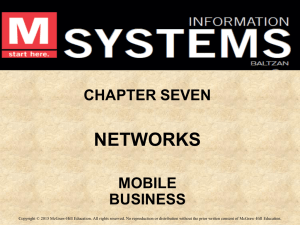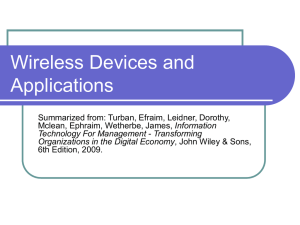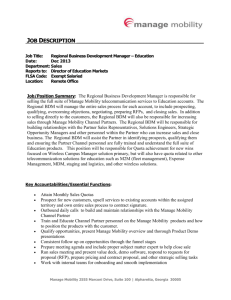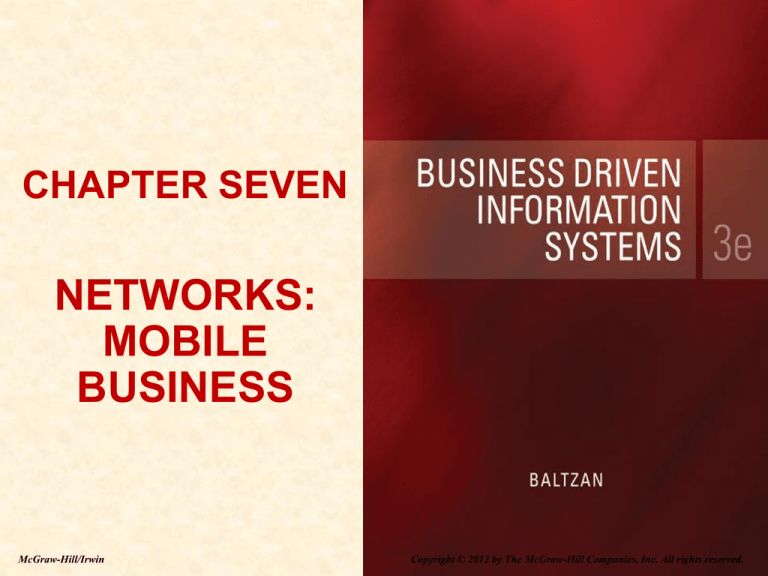
CHAPTER SEVEN
NETWORKS:
MOBILE
BUSINESS
McGraw-Hill/Irwin
Copyright © 2012 by The McGraw-Hill Companies, Inc. All rights reserved.
7-2
OVERVIEW OF A CONNECTED
WORLD
Networking Elements Creating a Connected World
7-3
NETWORK CATEGORIES
Local area network (LAN) Connects a group of computers in
close proximity, such as in an office
building, school, or home
Wide area network (WAN) - Spans a
large geographic area such as a state,
province, or country
Metropolitan area network (MAN) A large computer network usually
spanning a city
7-4
NETWORK PROVIDERS
National service providers (NSPs) - Private
companies that own and maintain the worldwide
backbone that supports the Internet
Network access points (NAPs) - Traffic
exchange points in the routing hierarchy of the
Internet that connects NSPs
Regional service providers (RSPs) - Offer
Internet service by connecting to NSPs, but they
also can connect directly to each other
7-5
NETWORK ACCESS TECHNOLOGIES
Bandwidth - The maximum amount
of data that can pass from one point
to another in a unit of time
• Bit
• Bit rate
• Modem
7-6
NETWORK ACCESS TECHNOLOGIES
Broadband – A high-speed Internet
connection that is always connected
• Digital subscriber line
• Internet cable connection
• T1 lines
7-7
NETWORK PROTOCOLS
Protocol - A standard that specifies the format
of data as well as the rules to be followed during
transmission
Transmission control protocol/Internet
protocol (TCP/IP) - Provides the technical
foundation for the public Internet as well as for
large numbers of private networks
Domain name system – Converts
IP addresses into domains
7-8
NETWORK CONVERGENCE
Network convergence - The efficient
coexistence of telephone, video, and data
communication within a single network, offering
convenience and flexibility not possible with
separate infrastructures
7-9
BENEFITS OF A CONNECTED
WORLD
Networks offer many advantages for a
business including
• Sharing resources
• Providing opportunities
• Reducing travel
7-10
SHARING RESOURCES
The primary resources for sharing include
• Intranet
• Extranet
• Virtual private network
7-11
CHALLENGES OF A CONNECTED
WORLD
Networks have created a diverse, yet globally
connected world by eliminating time and
distance, networks make it possible to
communicate in ways not previously imaginable
Even though networks provide many business
advantages, they also create increased
challenges in
• Security
• Social, ethical, and political issues
7-12
WIRELESS NETWORK
CATEGORIES
7-13
BUSINESS APPLICATIONS OF
WIRELESS NETWORKS
Areas experiencing tremendous growth using
wireless technologies include
• Radio-frequency identification (RFID)
• Global positioning system
• Geographic information system
• Location-based services
7-14
BENEFITS OF BUSINESS MOBILITY
Enhance mobility
Provides immediate data access
Increases location and monitoring capability
Improves work flow
Provides mobile business opportunities
Provides alternative to wiring
7-15
CHALLENGES OF BUSINESS
MOBILITY
Protecting against theft
Protecting wireless connections
Preventing viruses on a mobile device
Addressing privacy concerns with RFID and
LBS


